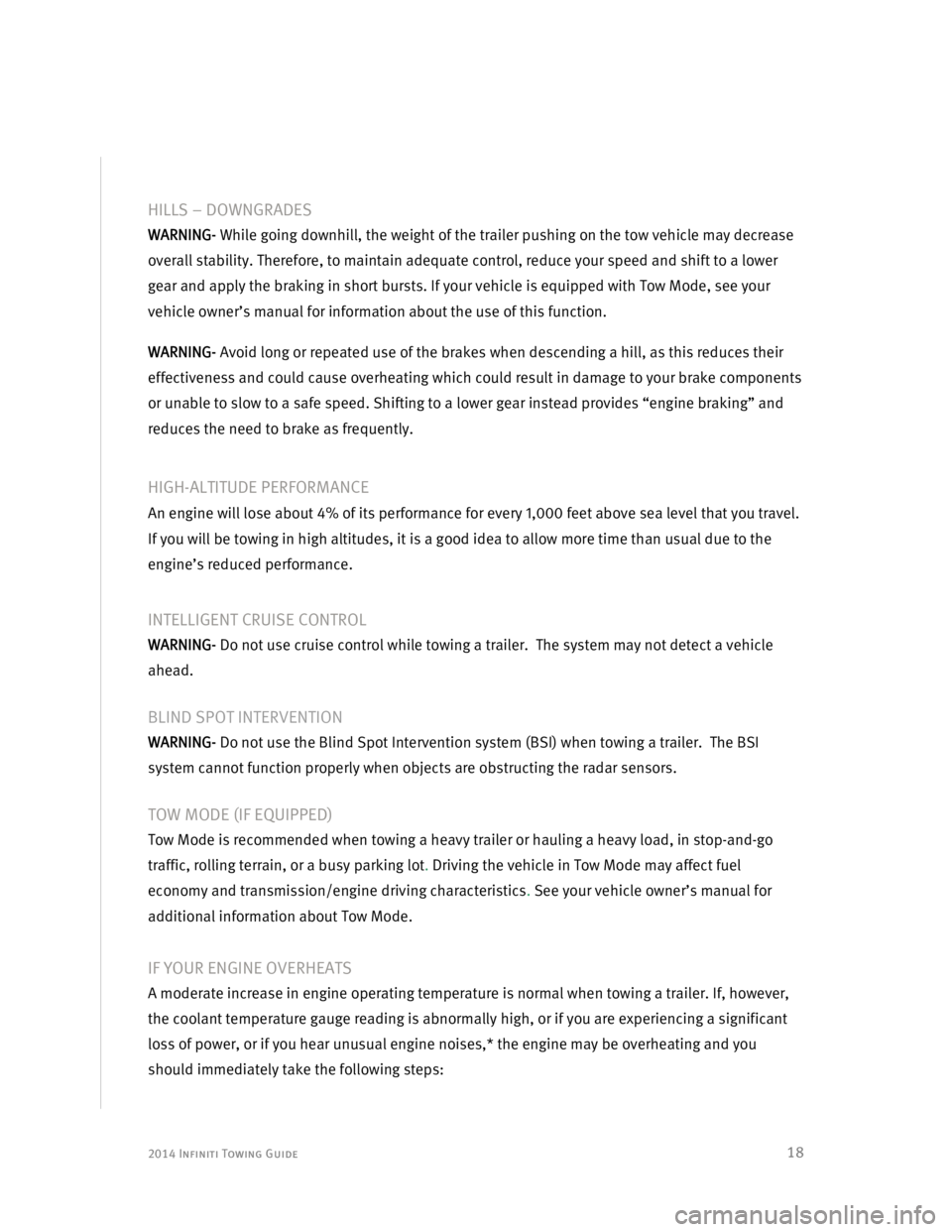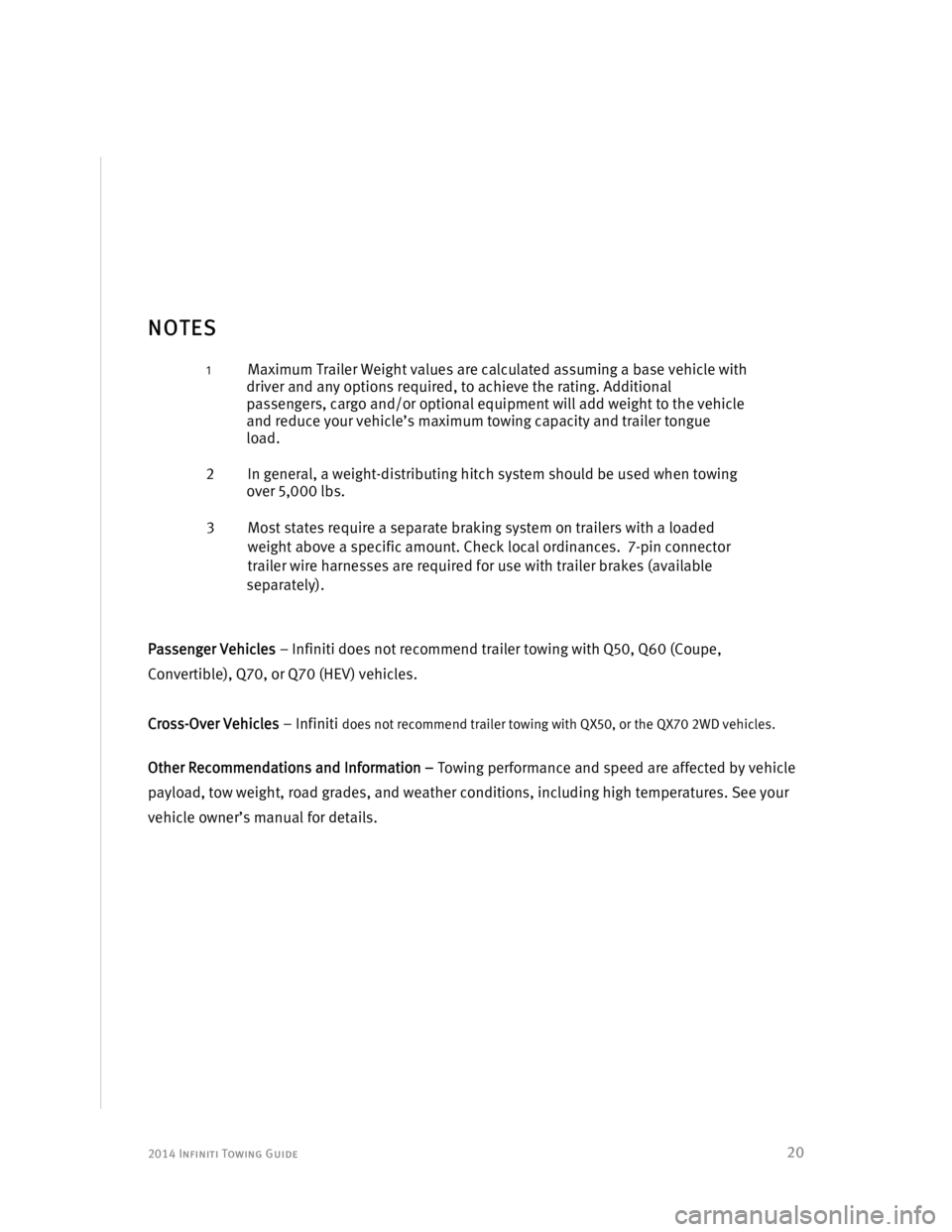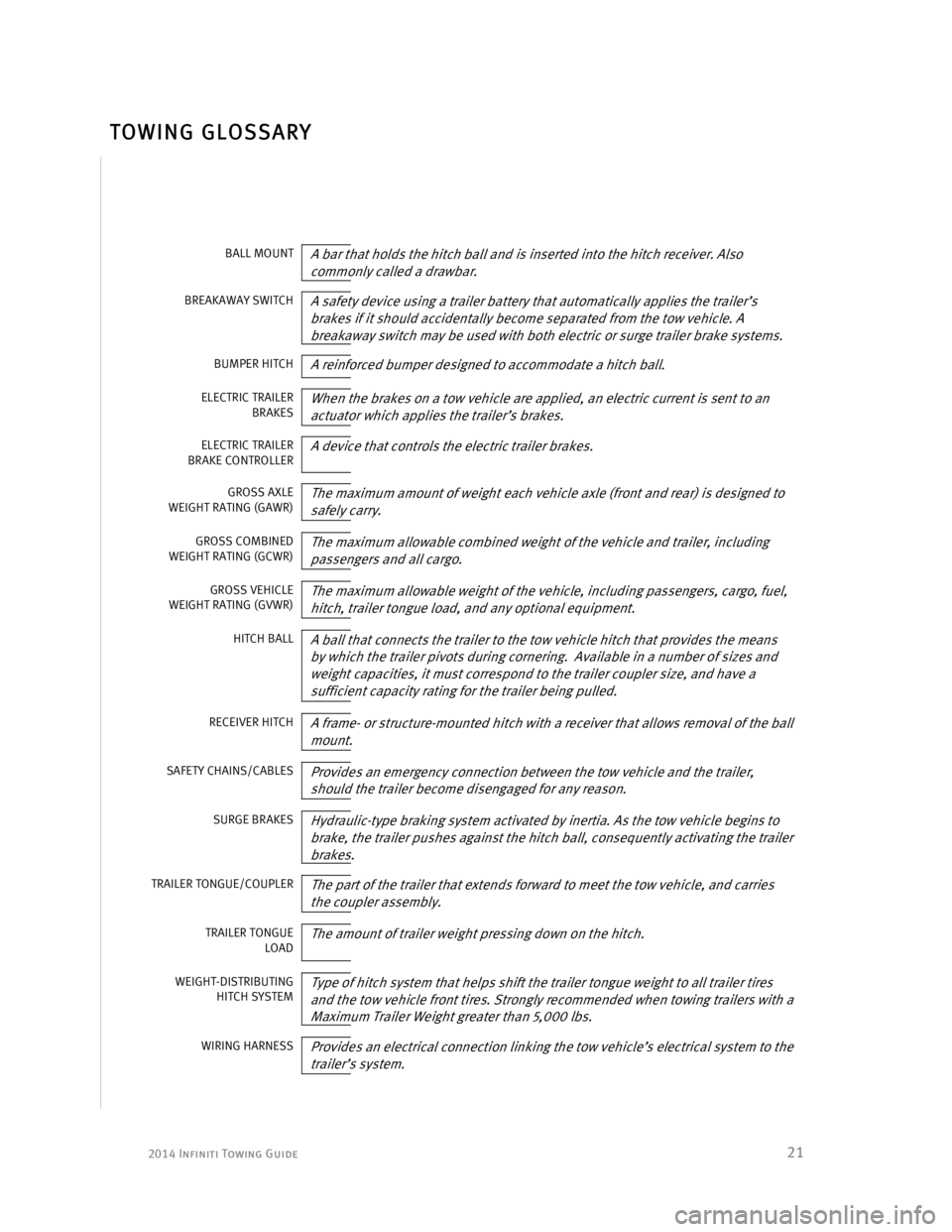brakes INFINITI QX80 2014 Towing Guide
[x] Cancel search | Manufacturer: INFINITI, Model Year: 2014, Model line: QX80, Model: INFINITI QX80 2014Pages: 25, PDF Size: 0.88 MB
Page 19 of 25

2014 Infiniti Towing Guide
18
HILLS – DOWNGRADES
WARNING- While going downhill, the weight of the trailer pushing on the tow vehicle may decrease
overall stability. Therefore, to maintain adequate control, reduce your speed and shift to a lower
gear and apply the braking in short bursts. If your vehicle is equipped with Tow Mode, see your
vehicle owner’s manual for information about the use of this function.
WARNING- Avoid long or repeated use of the brakes when descending a hill, as this reduces their
effectiveness and could cause overheating which could result in damage to your brake components
or unable to slow to a safe speed. Shifting to a lower gear instead provides “engine braking” and
reduces the need to brake as frequently.
HIGH-ALTITUDE PERFORMANCE
An engine will lose about 4% of its performance for every 1,000 feet above sea level that you travel.
If you will be towing in high altitudes, it is a good idea to allow more time than usual due to the
engine’s reduced performance.
INTELLIGENT CRUISE CONTROL
WARNING- Do not use cruise control while towing a trailer. The system may not detect a vehicle
ahead.
BLIND SPOT INTERVENTION
WARNING- Do not use the Blind Spot Intervention system (BSI) when towing a trailer. The BSI
system cannot function properly when objects are obstructing the radar sensors.
TOW MODE (IF EQUIPPED)
Tow Mode is recommended when towing a heavy trailer or hauling a heavy load, in stop-and-go
traffic, rolling terrain, or a busy parking lot. Driving the vehicle in Tow Mode may affect fuel
economy and transmission/engine driving characteristics. See your vehicle owner’s manual for
additional information about Tow Mode.
IF YOUR ENGINE OVERHEATS
A moderate increase in engine operating temperature is normal when towing a trailer. If, however,
the coolant temperature gauge reading is abnormally high, or if you are experiencing a significant
loss of power, or if you hear unusual engine noises,* the engine may be overheating and you
should immediately take the following steps:
Page 21 of 25

2014 Infiniti Towing Guide
20
NOTES
Passenger Vehicles – Infiniti does not recommend trailer towing with Q50, Q60 (Coupe,
Convertible), Q70, or Q70 (HEV) vehicles.
Cross-Over Vehicles – Infiniti
does not recommend trailer towing with QX50, or the QX70 2WD vehicles.
Other Recommendations and Information – Towing performance and speed are affected by vehicle
payload, tow weight, road grades, and weather conditions, including high temperatures. See your
vehicle owner’s manual for details.
1 Maximum Trailer Weight values are calculated assuming a base vehicle with
driver and any options required, to achieve the rating. Additional
passengers, cargo and/or optional equipment will add weight to the vehicle
and reduce your vehicle’s maximum towing capacity and trailer tongue
load.
2 In general, a weight-distributing hitch system should be used when towing
over 5,000 lbs.
3 Most states require a separate braking system on trailers with a loaded
weight above a specific amount. Check local ordinances. 7-pin connector
trailer wire harnesses are required for use with trailer brakes (available
separately).
Page 22 of 25

2014 Infiniti Towing Guide
21
BALL MOUNT A bar that holds the hitch ball and is inserted into the hitch receiver. Also
commonly called a drawbar.
BREAKAWAY SWITCH A safety device using a trailer battery that automatically applies the trailer’s
brakes if it should accidentally become separated from the tow vehicle. A
breakaway switch may be used with both electric or surge trailer brake systems.
BUMPER HITCH A reinforced bumper designed to accommodate a hitch ball.
ELECTRIC TRAILER BRAKES When the brakes on a tow vehicle are applied, an electric current is sent to an
actuator which applies the trailer’s brakes.
ELECTRIC TRAILER BRAKE CONTROLLER A device that controls the electric trailer brakes.
GROSS AXLE WEIGHT RATING (GAWR) The maximum amount of weight each vehicle axle (front and rear) is designed to
safely carry.
GROSS COMBINED WEIGHT RATING (GCWR) The maximum allowable combined weight of the vehicle and trailer, including
passengers and all cargo.
GROSS VEHICLE
WEIGHT RATING (GVWR) The maximum allowable weight of the vehicle, including passengers, cargo, fuel,
hitch, trailer tongue load, and any optional equipment.
HITCH BALL
A ball that connects the trailer to the tow vehicle hitch that provides the means
by which the trailer pivots during cornering. Available in a number of sizes and
weight capacities, it must correspond to the trailer coupler size, and have a
sufficient capacity rating for the trailer being pulled.
RECEIVER HITCH A frame- or structure-mounted hitch with a receiver that allows removal of the ball
mount.
SAFETY CHAINS/CABLES Provides an emergency connection between the tow vehicle and the trailer,
should the trailer become disengaged for any reason.
SURGE BRAKES
Hydraulic-type braking system activated by inertia. As the tow vehicle begins to
brake, the trailer pushes against the hitch ball, consequently activating the trailer
brakes.
TRAILER TONGUE/COUPLER The part of the trailer that extends forward to meet the tow vehicle, and carries
the coupler assembly.
TRAILER TONGUE
LOAD The amount of trailer weight pressing down on the hitch.
WEIGHT-DISTRIBUTING
HITCH SYSTEM Type of hitch system that helps shift the trailer tongue weight to all trailer tires
and the tow vehicle front tires. Strongly recommended when towing trailers with a
Maximum Trailer Weight greater than 5,000 lbs.
WIRING HARNESS
Provides an electrical connection linking the tow vehicle’s electrical system to the
trailer’s system.
TOWING GLOSSARY